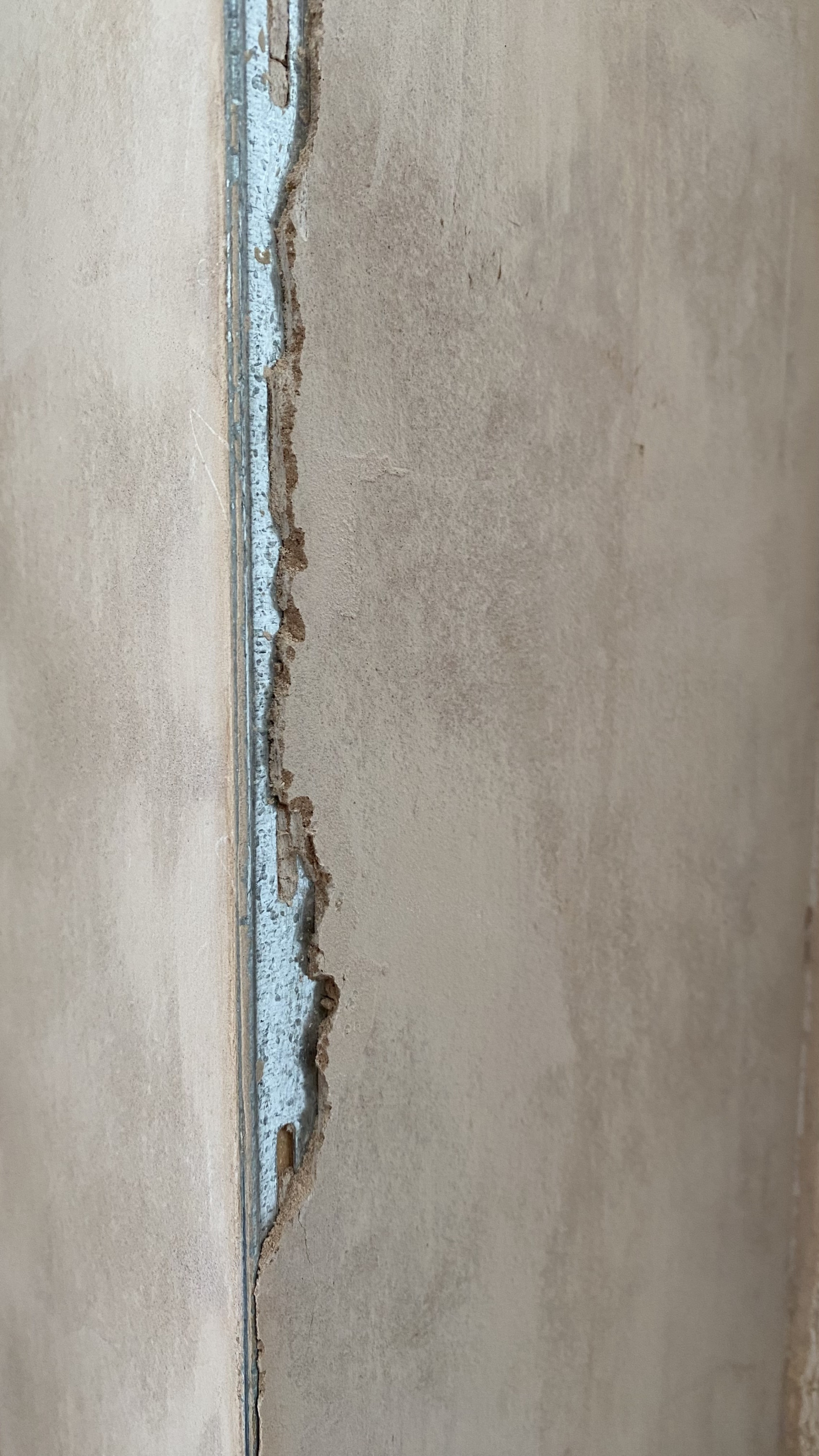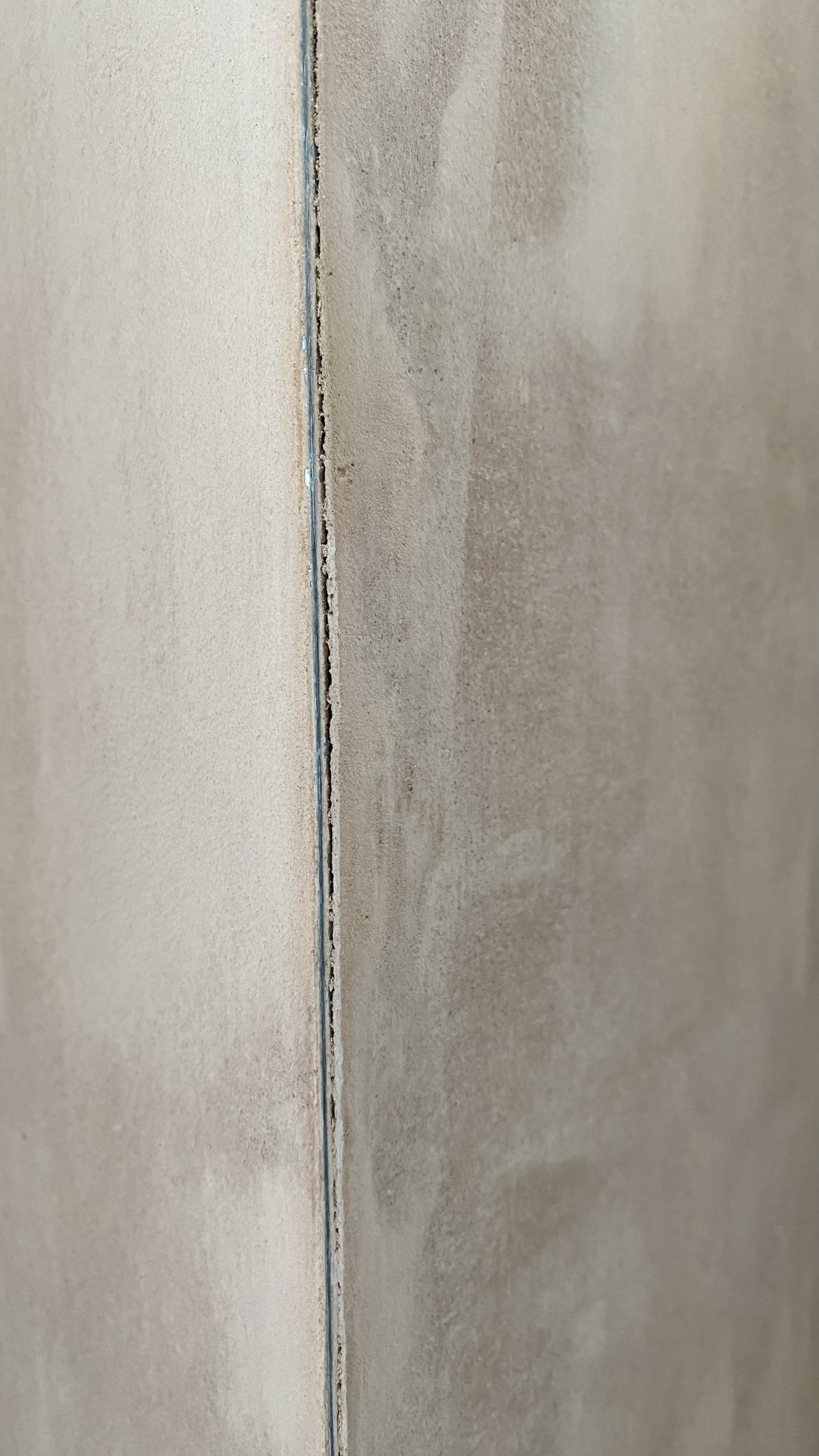We’d like to remind Forumites to please avoid political debate on the Forum.
This is to keep it a safe and useful space for MoneySaving discussions. Threads that are – or become – political in nature may be removed in line with the Forum’s rules. Thank you for your understanding.
The MSE Forum Team would like to wish you all a Merry Christmas. However, we know this time of year can be difficult for some. If you're struggling during the festive period, here's a list of organisations that might be able to help
📨 Have you signed up to the Forum's new Email Digest yet? Get a selection of trending threads sent straight to your inbox daily, weekly or monthly!
Plaster – Corner Bead Cracking?
paperclap
Posts: 779 Forumite




Hi all,
Two days ago, I'd skimmed some plasterboard (boxing in).
PVA'd the day before, waited for that to dry. Then PVA'd, waited to go tacky, first coat of MultFinish on. After it had started to set, second coat on. Then, three wet trowels.
Corner beads were stapled in place.
Two boxing ins haven't cracked down the corner bead. But this one has. What gives? Could it be as simple as it had dried out too fast due to the PVA not staying on the corner bead (PVA has a tendency to drip down)? Looks like it hasn't bonded properly to the corner bead.
FYI, I'm showing two sections. One where I'd hacked some loose plaster off, another where it's still showing the crack.
Either way, what's the best way to fix? PVA again, and use MultiFinish (2 coats)? Or just fill with EasiFill? Would much prefer to use what I've got (MultiFinish!).
P.S. This is my very first time plastering (ever!), so don't kill me too much for a bad job
Thanks!


Two days ago, I'd skimmed some plasterboard (boxing in).
PVA'd the day before, waited for that to dry. Then PVA'd, waited to go tacky, first coat of MultFinish on. After it had started to set, second coat on. Then, three wet trowels.
Corner beads were stapled in place.
Two boxing ins haven't cracked down the corner bead. But this one has. What gives? Could it be as simple as it had dried out too fast due to the PVA not staying on the corner bead (PVA has a tendency to drip down)? Looks like it hasn't bonded properly to the corner bead.
FYI, I'm showing two sections. One where I'd hacked some loose plaster off, another where it's still showing the crack.
Either way, what's the best way to fix? PVA again, and use MultiFinish (2 coats)? Or just fill with EasiFill? Would much prefer to use what I've got (MultiFinish!).
P.S. This is my very first time plastering (ever!), so don't kill me too much for a bad job
Thanks!


0
Comments
-
You don't need PVA on virgin plasterboard. You'd also would have been better off using plastic beads rather than galvanised steel. Steel will rust, so if you ever have to do similar work in a kitchen or bathroom, bear that in mind.As to why the plaster is cracking & pulling away - I suspect that you didn't use enough pressure when applying the first coat, and the plaster didn't stick to the PVA.I'd suggest digging the loose bits out and using some filler (Easyfill or Knauf Fill & Finish).Any language construct that forces such insanity in this case should be abandoned without regrets. –
Erik Aronesty, 2014
Treasure the moments that you have. Savour them for as long as you can for they will never come back again.2 -
You’d be right in saying that you don’t usually need to use PVA on plasterboard. But when the plasterboard is so old (reused), it’s definitely needed! Used Multifinish on this prior, without PVA, and it sucked all the moisture out of it almost instantly.
Surely the only reason it would potentially start to rust is if there was excess moisture getting to it? And plus as you say, they’re galvanised after all!
Gotcha, thank you. Dig out the loose stuff and fill back in. But any reason why EasiFill (or similar) over using MultiFinish?0 -
That's strange - it really hasn't stuck to that bead at all, has it?What PVA did you use - a 'wood' glue, or a 'building' type? Normal PVA will likely not stick that well to smooth galv'd steel - I bet if you tried, you could peel off an applied layer?Or, perhaps the bead was 'greasy' from a manufacturing residue?I would hope that slightly thinned PVA would capillary in there quite successfully - if it does, keep applying it until no more gets sucked in. Then, wipe away, with a damp cloth, all traces from the top skim surfaces or it'll leave a horrible skin that would won't be able to sand neatly.I'd, too, recommend plastic beading - or SS if you want to push the boat out. As a plastering novice - and I count myself in that too - you should expect to have to do some sanding to get the finish properly acceptable. If that sanding goes on to the bead, the galv will quickly come off - guess what you'll then get?
 Were the p'boards firmly joined together at that corner - there isn't excess movement?You can try using more multifinish as a filler - see how it goes. But you'll need to dampen the surrounding dried skim or it'll suck. Why best to use 'filler'? I guess because it's designed for easy and smooth sanding - multi isn't, tho' it can be.0
Were the p'boards firmly joined together at that corner - there isn't excess movement?You can try using more multifinish as a filler - see how it goes. But you'll need to dampen the surrounding dried skim or it'll suck. Why best to use 'filler'? I guess because it's designed for easy and smooth sanding - multi isn't, tho' it can be.0 -
It’s strange indeed!
The plaster has bonded behind the bead on to the edge of the board, but yeah, just not the steel itself. What is weird though, is it’s only this right side. The left side seems absolutely fine. No cracks or delamination. All okay, like all the other beads on the other boxing ins.
After a few wet trowels you start to think “well this finish ain’t so bad”. Then you wait for it to dry, shine a light up it closely, and you start to realise all the issues with it, haha! It really is an art to get perfect.
Yep, I’d used a builders PVA (not wood glue). Diluted to around a 3:1 mix. I’ll give MultiFinish a go, just because I’ve got a bag open really!
Cheers guys1 -
Ha-ha - yes, the skim can look great when it's still wet and pink. Then it dries...I have to put an inordinate amount of effort into achieving an acceptable finish, holding the trowel at ever-increasing angles until it's prob over 45o and acting as a scraper! Even then I usually have to run a flat block and some 160 over it once dry. But, hey, it works.Seriously impressed with what you are achieving.0
-
Wouldn't it typically be blue grit primer rather than PVA in this instance?paperclap said:. But when the plasterboard is so old (reused), it’s definitely needed! Used Multifinish on this prior, without PVA, and it sucked all the moisture out of it almost instantly.In the game of chess you can never let your adversary see your pieces0 -
I'll have to do some light sanding here and there, but expected to have to do that anyhow!

I've heard a lot about Blue Grit recently. Maybe it's better, maybe it's not – could you explain why Blue Grit would be better in this instance? Simply used PVA because it's what I had to hand!0 -
Alll too easy to scrape the galvanising off with the edge of the trowel (which is just as bad). The plastic beading also has a lot of holes, so gives more area for plaster to bind to the substrate.ThisIsWeird said: I'd, too, recommend plastic beading - or SS if you want to push the boat out. As a plastering novice - and I count myself in that too - you should expect to have to do some sanding to get the finish properly acceptable. If that sanding goes on to the bead, the galv will quickly come off - guess what you'll then get?
Any language construct that forces such insanity in this case should be abandoned without regrets. –
Erik Aronesty, 2014
Treasure the moments that you have. Savour them for as long as you can for they will never come back again.1 -
paperclap said:I'll have to do some light sanding here and there, but expected to have to do that anyhow!

I've heard a lot about Blue Grit recently. Maybe it's better, maybe it's not – could you explain why Blue Grit would be better in this instance? Simply used PVA because it's what I had to hand!Blue Grit is purpose made for that job - it adheres well, and gives a nice surface to take a skim.PVA is often used - successfully - too, especially when you have a range of different surfaces, with different levels of adhesion and porosity, to skim. But I'd question how well it sticks to smooth metal. I bet you can peel it away once dry.0 -
The aggregate creates a decent surface for the plaster to key to and I believe it prevents the surface sucking the water out the plaster, plus being blue you can easily ensure you've covered the whole area.paperclap said:
I've heard a lot about Blue Grit recently. Maybe it's better, maybe it's not – could you explain why Blue Grit would be better in this instance? In the game of chess you can never let your adversary see your pieces0
In the game of chess you can never let your adversary see your pieces0
Confirm your email address to Create Threads and Reply

Categories
- All Categories
- 352.9K Banking & Borrowing
- 253.9K Reduce Debt & Boost Income
- 454.7K Spending & Discounts
- 246K Work, Benefits & Business
- 602.1K Mortgages, Homes & Bills
- 177.8K Life & Family
- 259.9K Travel & Transport
- 1.5M Hobbies & Leisure
- 16K Discuss & Feedback
- 37.7K Read-Only Boards




